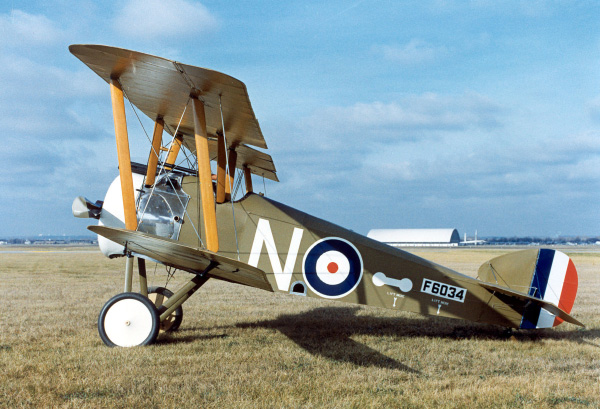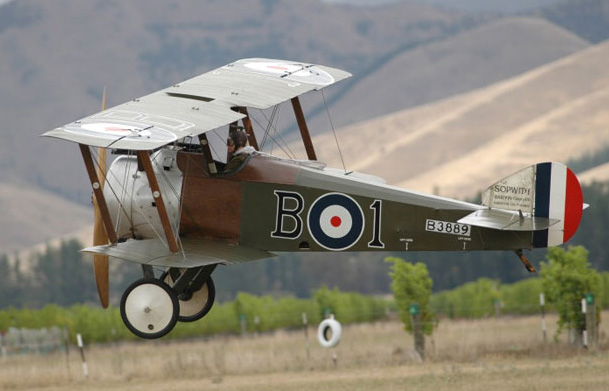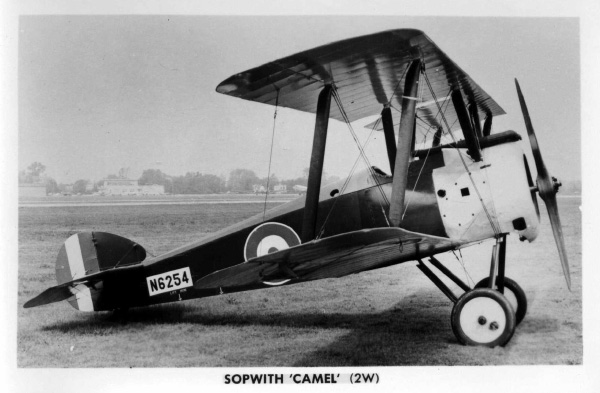
|
Sopwith Camel |  |
||||||||
|---|---|---|---|---|---|---|---|---|---|---|
 |
 |
 |
 |
 |
 |
 |
 |
 |
 |

|
||
|
A successor to the Sopwith Pup, the Sopwith Aviation Company produced the famous Sopwith F.1 Camel, which accounted for more victories than any other aircraft in World War I.
|
||
|
The Sopwith Camel F.1 was a direct development of Herbert Smith's Sopwith Pup and the two planes were not dissimilar in appearance, but this is where the simularity ended. Unlike the elegant and docile handling Pup, the Camel was a high strung animal, difficult and dangerous to fly. Deadly in the hands of a novice, many a student was killed while learning to fly the Camel, but in the hands of a skilled pilot, able to take advantage of its temperamental flying characteristics, it was an extreme dog-fighter that could out maneuver any contemporary airplane with the possible exception of the Fokker Dr.I Triplane.1
The Camel was a larger and heavier version of the Pup that was very sensitive to flight control inputs, due to the close proximity of the engine, cockpit and fuel as well as the torque effect of the rotary engine. The engine, guns, pilot, cockpit and fuel were all concentrated in a length of seven feet, and the central distribution of weight, along with the engine torque, caused the plane to climb in a left turn and dive in a right turn, which if not corrected would result in a disastrous spin.2 Although extreme in handling qualities, it was these very characteristics that made it a lethal weapon. Its deliberate instability made the Camel the perfect dogfighter. With ailerons on both wings, it could turn tight corners where suddenly, a German pursuer could find himself the pursued. It leveled the technological battlefield above the trenches where a pilot could perform aerial gymnastics with ease. |
| The World War I rotary engines had a unique operating characteristic in which the engine crankcase and cylinders would rotate, while the crankshaft was stationary. The weight of the spinning engine mass created a gyroscopic effect, which would impact the flying characteristics of the airplane. The induced torque effect into the airframe created a limitation for the rotary engines as aircraft grew in size requiring rpm above 1,400 and ever greater horsepower.3 |
| Construction of the Camel was of staggered wire braced wing bays with a straight upper wing and a very pronounced dihedral on the lower wing. The prototype upper wing panel was designed to be a single unit in order to simplify construction. However, the production wing was three panels with an aft cutout between the spars and a center window for increased upper visibility, but the upper wing remained without dihedral—to compensate, the lower wing dihedral was doubled.4 Ailerons were fitted on both the upper and lower wings with the ailerons of a slightly greater span on the production models. |

| ||
|
The engine, guns, pilot, cockpit and fuel were all concentrated in a length of seven feet of the fuselage. Aluminum panels covered the first bay behind the engine and plywood was installed to the end of the cockpit, with the remainder of the fuselage covered in fabric.
| ||
|
The fuselage had a rounded top conventional wire braced wooden frame, typical of the period. Aluminum panels covered the first bay behind the engine, and plywood was installed to the end of the cockpit, with the remainder of the fuselage covered in fabric. With the engine, guns, pilot, cockpit and fuel all concentrated in a length of seven feet, this became one of the main contributing factors of the Camel's excellent maneuverability. For the pilot, a small windscreen was fitted behind the guns. The landing gear had short steel tube vees with a split axle, with rather large wheels.
It was the first British type to carry twin Vickers guns as standard equipment.5 The guns were synchronized to fire through the prop arc and the gun breeches were enclosed in a cowling which gave it the appearance of a hump and thereby gave the Camel its name. The feed-block of the standard Vickers gun was on the right hand side, but towards the end of 1917, the Camel's guns featured both left and right feed-blocks to improve ammunition feeding and ejection.6 The Le Rhone Camels were fitted with a hydraulic Constantinesco interrupter gear,7 while the Clerget Camels had the less efficient Sopwith-Kauper No. 3 mechanical synchronizing gear.8 The Vickers gun was belt fed and had a higher rate of fire compared to the magazine fed Lewis gun, which required a magazine change every 97 rounds.9 A big disadvantage of the placement of the guns was in night-fighting—the gun flashes would blind the pilots by ruining their night vision.10 (Night vision develops as your eyes become dark adapted over a period of several minutes. Any exposure to bright light will immediately destroy night vision with the exception of red, which is why red lights were originally the choice for instruments in airplanes and submarines. Red lights are also used by astronomers.) To correct this problem, a special (home defense) night fighter was built with twin Lewis guns mounted on the top wing panel, on a Foster mount, and the pilot was moved further aft.11 Additional armament consisted of four 20 lb bombs carried under the fuselage for Trench Fighter duties. The high casualty rate led to the development of the (TF.1) Trench Fighter 1., which had armor plating for protection of the pilot. The TF.1 was the forerunner of the TF.2 Salamander. |

|
|
The prototype was powered by a 110 hp Clerget 9Z rotary engine, but the F.1 production models used the 130 hp Clerget 9B or 150 hp (B.R.1) Bentley Rotary 1.12 The Clerget engine had a tendency to choke and quit if the fuel-air mixture was not leaned out after climbing more than 200 ft.13 Being tail heavy, the Camel would tend to stall and spin without power. Other engines used were the 110 hp Le Rhone14 or the 110 hp Gnome Monosoupape.15 The Gnome Monosoupape was considered a less reliable engine because of its single valve operation and the 110 hp Le Rhone actually produced 130 hp.16 The most powerful engine to be used in the Camel (c/n B3891) was the French built 170 hp Le Rhone 9R. With the more powerful engines, the Camel was able to climb to 10,000 feet in less than ten minutes.
By the end of July 1917 the first RFC deliveries were made to No. 70 squadron and by the end of the year the No. 6 RNAS was completely equipped—the year ended with a total of 1,325 Camels delivered.17 143 Camels were purchased by the American Expeditionary Force, but they were fitted with the less dependable Gnome Monosoupape engines. From July 1917, when it reached the Front, until the Armistice, the Camel accounted for no less than 1,294 victories—more than any other aircraft in World War I.18 The Camel was used in the Battle of Ypres in July 1917 and participated on offensive patrols and ground strafing. The Camel also served as a light bomber and in one operation the No. 28 and 70 squadrons bombed the Rumbeke Aerodrome with twenty-two 25 lb bombs. The Royal Navy version of the Camel was the 2F.1 which had a slightly smaller wing span. The starboard Vickers gun was replaced with an upward angled Lewis gun, firing through the center section cutout. 340 2F.1 Camels were built, but did not become operational until 1918. The 2F.1 also operated as a dive bomber carrying two 50 lb. bombs under the fuselage. Camels served on five aircraft carriers, two battleships and twenty-six cruisers. The last Zeppelin (L 53) shot down in the war was by a Camel—piloted by Lieutenant Culley on August 10, 1918.19 The Camel did not remain long in post-war service with the RAF and was replaced with the Sopwith Snipe. However, it continued in service with the Belgian Aviation Militaire, The Canadian Air Force, the Royal Hellenic Naval Air Service, the Polish Air Force, and the US Navy. A total of 5,490 camels were ordered, but the actual number of aircraft delivered has not been determined. |
| Specifications: | |||||
|---|---|---|---|---|---|
| Sopwith Camel F.1 | |||||
| Dimensions: | |||||
| Wing span: | 28 ft 0 in (8.50 m) | 28 ft 0 in (8.50 m) | 28 ft 0 in (8.50 m) | 28 ft 0 in (8.50 m) | |
| Length: | 18 ft 9 in (5.50 m) | 18 ft 6 in (5.70 m) | 18 ft 8 in (5.60 m) | ||
| Height: | 8 ft 6 in (2.60 m) | 8 ft 6 in (2.60 m) | 8 ft 6 in (2.60 m) | 8 ft 6 in (2.60 m) | |
| Wing Area: | 231 sq ft (21.50 sq m) | 231 sq ft (21.50 sq m) | 231 sq ft (21.50 sq m) | 231 sq ft (21.50 sq m) | |
| Weights: | |||||
| Empty: | 962 lbs (436 kg) | 977 lbs (443 kg) | 889 lbs (403 kg) | 1,048 lbs (475 kg) | |
| Maximum T/O: | 1,482 lbs (672 kg) | 1,508 lbs (680 kg) | 1,422 lbs (645 kg) | 1,567 lbs (711 kg) | |
| Performance: | |||||
| Max. Speed 10,000 ft (3,050 m): |
104.5 mph (168 km/hr) | 111 mph (179 km/hr) | 118.5 mph (191 km/hr) | 113 mph (182 km/hr) | |
| Max. Speed 15,000 ft (4,570 m): |
97.5 mph (157 km/hr) | 103 mph (166 km/hr) | 111.5 mph (179 km/hr) | 108.5 mph (175 km/hr) | |
| Service Ceiling: | 18,000 ft (5,480 m) | 18,000 ft (5,480 m) | 21,500 ft (6,550 m) | ||
| Climb to 10,000 ft (3,050 m): |
11 min., 45 sec. | 9 min., 50 sec. | 9 min., 10 sec. | 9 min., 35 sec. | |
| Climb to 15,000 ft (4,570 m): |
23 min., 15 sec. | 20 min., 0 sec. | 16 min., 50 sec. | 17 min., 30 sec. | |
| Powerplant: | |||||
| 9 cyl., 130 hp (96 kW) Clerget rotary. |
9 cyl., 150 hp (00 kW) Bentley B.R.1 rotary. |
9 cyl., 110 hp (00 kW) Le Rhone rotary. (actual 137 hp) |
9 cyl., 170 hp (00 kW) Le Rhone rotary. |
||
| Armament: | |||||
| Twin Vickers machine guns or one central mounted Vickers mg and one overhead Foster mounted Lewis mg. Balloon Buster Camels carried one upward firing Lewis mg. Ground attack Camels carried up to four under-fuselage 20 lb bombs. | |||||
| Endnotes: |
|---|
|
1. J.M. Bruce. British Aeroplanes 1914-18. New York: Funk & Wagnalls, 1957. 574. 2. Herbert M. Mason, Jr. The United States Air Force, A Turbulent History. New York: Mason/Charter, 1976. 58. 3. Herschel Smith. A History of Aircraft Piston Engines. Manhattan, Kansas: Sunflower University Press, 1986. 64. 4. J.M. Bruce. Aircraft in Profile Volume 2. The Sopwith Camel F.1. Surrey, England; Profile Publications Ltd., 1965. 6. 5. E.F. Cheesman ed. Fighter Aircraft of the 1914-1918 war. Fallbrook, California: Aero Publishers Inc., 1964. 60. 6. H.F. King. Sopwith Aircraft 1912-1920. London: Putnam, 1980. 148. 7. Kenneth Munson. The Pocket Encyclopedia of World Aircraft in Color. Fighters 1914-19. Attack and Training Aircraft. New York: The MacMillan Company, 1969. 150. 8. J.M. Bruce. Aircraft in Profile Volume 2. The Sopwith Camel F.1. 5. 9. J.M. Bruce. British Aeroplanes 1914-18. 575. 10. E.F. Cheesman. 11. Ibid. 12. Kenneth Munson. 150. 13. E.F. Cheesman. 14. J.M. Bruce. British Aeroplanes 1914-18. 575. 15. E.F. Cheesman. 16. Herschel Smith. 57-64. 17. Kenneth Munson. 150. 18. J.M. Bruce. British Aeroplanes 1914-18. 574. 19. H.F. King. 176. |
© Larry Dwyer. The Aviation History Online Museum.
All rights reserved.
Created March 12, 2005. Updated February 1, 2020.